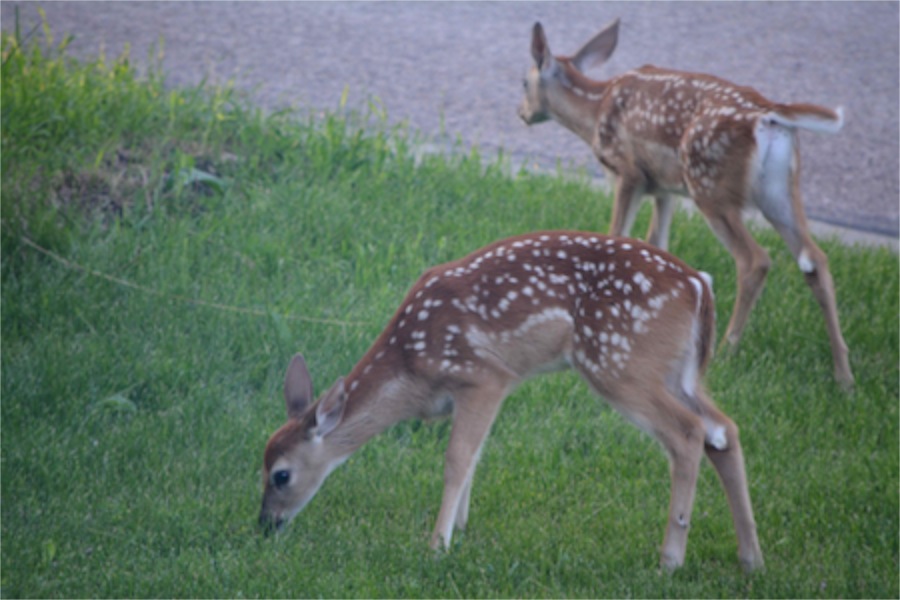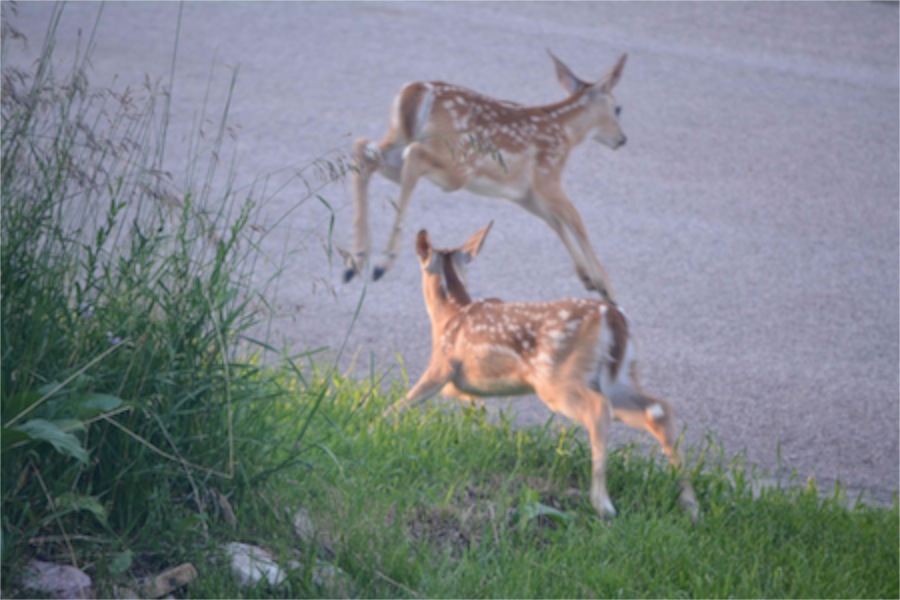Watching the neighbors
14/07/14 05:21
There are no written histories of the years prior to people of European descent coming to the Black Hills, but the oral histories report that the hills have long been abundant in a wide variety of game. Deer were the most numerous of species, with both black-tailed (mule) and white-tailed deer in abundance. In 1875, and expedition of 400 soldiers led by Lt. Col. Richard Irving Dodge came into the hills and made a somewhat systematic study of the deer, noting the differences in size and the locations in which they found deer. The expedition killed approximately 1,000 deer in their exploration. He noted in his report the from the time they entered the hills “scarcely a day passed without our seeing some of these beautiful animals.”
It only took about five years for the hunting pressure from market hunters to severely diminish the deer herds. Wagon loads of deer meet were taken to Deadwood to feed the miners. Similar hunting pressure was decreasing elk herds at the same time. In December of 1878 the Black Hills Weekly reported “if market hunters keep killing off the game at the current rate, they will be looking for different employment the next year.” However, it wasn’t until 1911 that there was any regulation of hunting in the hills and there were no set hunting seasons prior to the 1920’s.
These days the South Dakota Department of Game, Fish and Parks works hard to manage the Black Hills deer herds with an eye towards the health of the herd and the pressures caused by human encroachment into the habitat.
 Where we live we can echo Lt. Col. Dodge’s experience: “Scarcely a day goes by without us seeing one of these beautiful animals.” Our neighbors have an area in their back yard where they do not mow and it has become a good place for the does to have their fawns. This year we have three fawns who are spending their time in our immediate neighborhood and now that they are big enough to spend a little time out on their own and tall enough for us to spot when they are running in the tall grass, we have taken to keeping an eye on them. We think we have a set of twins plus one more fawn. The does are a bit harder to identify, but I think I know which one is the mother of the twins at least.
Where we live we can echo Lt. Col. Dodge’s experience: “Scarcely a day goes by without us seeing one of these beautiful animals.” Our neighbors have an area in their back yard where they do not mow and it has become a good place for the does to have their fawns. This year we have three fawns who are spending their time in our immediate neighborhood and now that they are big enough to spend a little time out on their own and tall enough for us to spot when they are running in the tall grass, we have taken to keeping an eye on them. We think we have a set of twins plus one more fawn. The does are a bit harder to identify, but I think I know which one is the mother of the twins at least.
At this stage of their lives, the biggest risk for the fawns is crossing Sheridan Lake Road, but for the most part they stay on our side of that road, finding plenty of food in our yard and the yards of the neighbors. We mow our grass, and the soft green shoots are attractive to the deer.
The fawns are simply fun to watch. They are much more flighty and easily startled than the older deer. We have to be quiet and move slowly if we want to observe them. But when we’re inside the house, they’ll come remarkably close to the house and give us a good view out of the windows.
Who knows why we are so attracted to young animals? It does work towards their preservation. From ancient days, humans have noticed and appreciated young animals, identified their mothers and hunters have, for the most part, respected and sheltered the young animals. Since there is no hunting in our neighborhood and this isn’t the hunting season at any rate, the animals are safe during their early months while they grow out of their spots and learn the ways of life in this semi-urban interface of animals and people.
 I haven’t quite figured out whether or not deer ever gain any street smarts. They seem to be particularly bad at looking for approaching cars, judging speed, and choosing when to cross the road. Traffic is supposed to be limited to 45 mph on Sheridan Lake Road behind our house, but there are plenty of cars that go by at least 10 mph faster than that. Despite many generations of deer growing up since the road has been busy, they don’t seem to have developed any particular skills at safe crossing. Those of us who live here and drive the roads regularly have gained some skills at knowing where the deer are likely to cross and keeping our eyes out for the animals, but anyone who lives and drives in the hills will occasionally have a deer strike accident. This time of the year, of course, the hills are filled with tourists who are less familiar with the roads, have their attention directed in other places, and are less used to looking out for the deer.
I haven’t quite figured out whether or not deer ever gain any street smarts. They seem to be particularly bad at looking for approaching cars, judging speed, and choosing when to cross the road. Traffic is supposed to be limited to 45 mph on Sheridan Lake Road behind our house, but there are plenty of cars that go by at least 10 mph faster than that. Despite many generations of deer growing up since the road has been busy, they don’t seem to have developed any particular skills at safe crossing. Those of us who live here and drive the roads regularly have gained some skills at knowing where the deer are likely to cross and keeping our eyes out for the animals, but anyone who lives and drives in the hills will occasionally have a deer strike accident. This time of the year, of course, the hills are filled with tourists who are less familiar with the roads, have their attention directed in other places, and are less used to looking out for the deer.
So we hold our breath when the fawns cross the busy street.
We do, however, count ourselves among the luckiest of people to be able to live in a place where we have deer in our back yard and we get to watch the fawns grow up each year. We make a bit of a sport of learning to spot them in the tall grass and some evenings spend quite a bit of time with what must look to the neighbors as idle staring into the woods. It is a different type of looking than was required of those who lived near these hills in the early days. We are not dependent upon the deer for our food. We don’t have to learn their ways so that we will be able to hunt to survive. Our winters aren’t dependent upon our being able to select the fattest of animals. We just watch the little ones grow up until they lose their spots and their colors and size make them pretty much indistinguishable from the rest of the herd. We can usually identify the yearlings, but beyond that all of the deer pretty much look the same to us.
We enjoy our human neighbors, but feel blessed to live in a neighborhood where some of our neighbors are four-legged, fast, and fascinating to watch.
It only took about five years for the hunting pressure from market hunters to severely diminish the deer herds. Wagon loads of deer meet were taken to Deadwood to feed the miners. Similar hunting pressure was decreasing elk herds at the same time. In December of 1878 the Black Hills Weekly reported “if market hunters keep killing off the game at the current rate, they will be looking for different employment the next year.” However, it wasn’t until 1911 that there was any regulation of hunting in the hills and there were no set hunting seasons prior to the 1920’s.
These days the South Dakota Department of Game, Fish and Parks works hard to manage the Black Hills deer herds with an eye towards the health of the herd and the pressures caused by human encroachment into the habitat.

At this stage of their lives, the biggest risk for the fawns is crossing Sheridan Lake Road, but for the most part they stay on our side of that road, finding plenty of food in our yard and the yards of the neighbors. We mow our grass, and the soft green shoots are attractive to the deer.
The fawns are simply fun to watch. They are much more flighty and easily startled than the older deer. We have to be quiet and move slowly if we want to observe them. But when we’re inside the house, they’ll come remarkably close to the house and give us a good view out of the windows.
Who knows why we are so attracted to young animals? It does work towards their preservation. From ancient days, humans have noticed and appreciated young animals, identified their mothers and hunters have, for the most part, respected and sheltered the young animals. Since there is no hunting in our neighborhood and this isn’t the hunting season at any rate, the animals are safe during their early months while they grow out of their spots and learn the ways of life in this semi-urban interface of animals and people.

So we hold our breath when the fawns cross the busy street.
We do, however, count ourselves among the luckiest of people to be able to live in a place where we have deer in our back yard and we get to watch the fawns grow up each year. We make a bit of a sport of learning to spot them in the tall grass and some evenings spend quite a bit of time with what must look to the neighbors as idle staring into the woods. It is a different type of looking than was required of those who lived near these hills in the early days. We are not dependent upon the deer for our food. We don’t have to learn their ways so that we will be able to hunt to survive. Our winters aren’t dependent upon our being able to select the fattest of animals. We just watch the little ones grow up until they lose their spots and their colors and size make them pretty much indistinguishable from the rest of the herd. We can usually identify the yearlings, but beyond that all of the deer pretty much look the same to us.
We enjoy our human neighbors, but feel blessed to live in a neighborhood where some of our neighbors are four-legged, fast, and fascinating to watch.